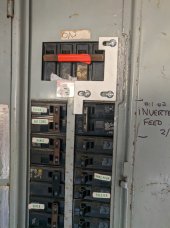tomy2
escape artist
Finished my setup at the subpanel with a small 125 amp box. Looking for another load panel to use at the main panel. Is a 125amp box limited to 125 total in breakers? or 125 amps max usage. they sell 125 panels with room for 20 breakers, even twenty 15 amp breakers would be 300 amps.
I had to locate the load panel above the existing subpanel in order to use the existing wires. I don't want to do that at the main panel. So I am looking to put the load panel side by side with the Main. Anybody using a load panel that would work? preferably with the neutral and ground busbars installed.
Here is a pic of my first instal, still needs a drywall patch.https://photos.app.goo.gl/Rbjp641uYxKrh5hD6
I had to locate the load panel above the existing subpanel in order to use the existing wires. I don't want to do that at the main panel. So I am looking to put the load panel side by side with the Main. Anybody using a load panel that would work? preferably with the neutral and ground busbars installed.
Here is a pic of my first instal, still needs a drywall patch.https://photos.app.goo.gl/Rbjp641uYxKrh5hD6



